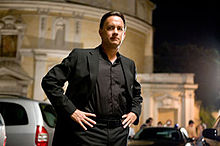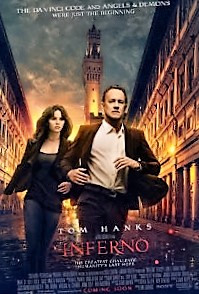Inferno **½ (2016, Tom Hanks, Ben Foster, Felicity Jones, Irrfan Khan, Sidse Babett Knudsen) – Movie Review
After all his previous problems in The Da Vinci Code and Angels & Demons (2009), you’d think Robert Langdon (Tom Hanks) would be enjoying some well deserved peace and quiet, especially after all those dead priests and parachuting popes, and that he’d stay away from Italy, wouldn’t you?
But, no, instead Langdon wakes up in a hospital in Florence, Italy, with amnesia, a headache and a bullet wound to the head. Don’t you just hate it when that happens? Jason Bourne had a not dissimilar problem in The Bourne Identity, you may recall. He didn’t like it either.
Anyhoo, a mad woman on a motorbike with a gun pretending to a be a lone cop comes after Langdon to kill him. But his nice kindly terribly English doctor, Sienna Brooks (Felicity Jones) saves him, getting him out of his hospital bed and into the very temporary safety of her bijou apartment. And soon they are evading umpteen bad guys and racing against the clock together through lovely tourist spots to foil a deadly global plot.
I really admire the way the film plunges right bang into the middle of the story, and we have to get our bearings like Langdon needs to find his somehow. Incidentally, just before all this, the film’s main villain Bertrand Zobrist (Ben Foster) has just chucked himself off one of Florence’s taller buildings to avoid capture by the sinister Christoph Bruder (Omar Sy). A hero facing a dead villain nemesis, that’s unusual. But, luckily for the story, Zobrist has provided lots of clues for Langdon to follow so that his own evil plan will be achieved posthumously.
The clues Langdon must decypher are connected to the works of the painter Sandro Botticelli and Dante Alighieri, the writer of Inferno. It looks like the film’s source novelist Dan Brown must have confined his research to the first chapter of Dante’s epic poem The Divine Comedy, for much of the plot revolves round it.
It involves unleashing a deadly virus that will cull a third or so of mankind because, in case you haven’t noticed, there are too many people on Earth, and multiplying too fast. Fewer tourists in Florence and Venice, that would be good, but the deadly virus solution seems a bit extreme, Zobrist! He is of course a kind of Bond-style villain, though it’s cute that he’s already dead and this time M15 doesn’t have to come after him to kill him.
High-class hokum, Inferno isn’t really very good but it is fast moving, great looking, quite exciting and quite fun and probably just a shade better than its 2009 predecessor. Like its hero, it keeps pacing breathlessly along and, when Dan Brown gets tired of tourist Florence (or thinks we will be), swiftly relocates to tourist Venice, then tourist Istanbul. With the pound so low, absolutely no need to go on holiday, guys, just go see Inferno.
Brown writes to formula, a hugely successful one, but a rigid formula none the less. That makes the movie formulaic too. Brown and director Ron Howard treat the audience to exotic European pleasures, both past and present. But they seem to lack respect for the audience intelligence, spinning a yarn that is exciting but daft, totally bonkers, tempting us with Italian goodies but in a superficial, glossy tourist way, telling us some interesting facts and showing us some dazzling sights, but not too many in case we get bored.
The film’s sense of Florence’s geography – the Palazzo Vecchio? – that’s next to the Boboli Gardens! – is like in one of those American movies that have the hero driving round Trafalgar Square and coming immediately upon Tower Bridge. Langdon’s licence to be a professor is hereby revoked because, conveniently for the American audience but not for credibility, he can’t speak or understand Italian, and has to have the story of Dante and his unrequited true love Beatrice explained to him, despite being the world expert on Dante and all things Italian.
Nevertheless, Langdon may be pretty stupid and ignorant for a professor, but he is able to do the one thing all professor’s have to be able to do – run! – it’s in the job description. And, with some stunt double and CGI help, Hanks is able to run quite nicely for an old bloke, thank you very much.
Hanks has never been well cast as Langdon but he gets by on his usual crumpled charisma, acting his way out of it, and establishes a good rapport with Jones, and later with Sidse Babett Knudsen as Dr Elizabeth Sinskey, a former lover who turns up like a bad penny to help the search for the deadly virus and recall the old days. Knudsen is well cast and effective, making you believe she could have has a past with Hanks, and maybe even a future. But the best performance comes from Irrfan Khan, chewing slimily over all the film’s best lines as the cynical villain Harry Sims ‘The Provost’, head of a shadowy consulting group called The Consortium – another Bond-style villain.
Admittedly The Lost Symbol (2009) remains to be filmed, but now that they’ve got a trilogy out of Robert Langdon, it’s time to call it a day. Hanks, Brown and Howard have got away with it, but it is time to move on guys.
© Derek Winnert 2016 Movie Review
Check out more reviews on http://derekwinnert.com




